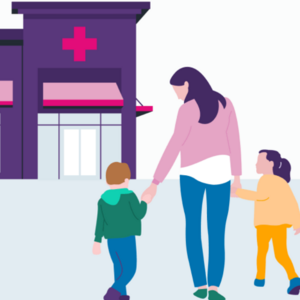
Feel better faster. Get care today.
From the clinic or your couch. Find high quality, same-day urgent care for you and your kids. Book an urgent care visit today.

Anaphylaxis is a severe, potentially life-threatening allergic reaction that can occur rapidly after exposure to an allergen—a substance to which an individual is allergic. According to the Cleveland Clinic, this extreme response by the immune system can affect multiple body systems, leading to a range of symptoms that may include skin reactions like hives, redness or swelling, constricted airways in the lungs, severe lowering of blood pressure, and dizziness or fainting. The Mayo Clinic notes that this severe allergic reaction can be triggered by various allergens, including certain foods, medications, insect stings, or latex, among others. Anaphylaxis requires immediate medical attention, according to the Cleveland Clinic. They note that this is because anaphylaxis can result in a state of shock, impaired breathing, or even death if not promptly and properly treated with medications such as epinephrine.
Anaphylaxis is a rapid-onset allergic reaction that can escalate through several stages, becoming increasingly severe without timely intervention, according to the Mayo Clinic. They explain that understanding the progression of anaphylaxis is crucial for recognizing the signs early and responding effectively.
The condition can unfold in four distinct stages, each with its own set of symptoms and implications for the affected individual's health, according to the Mayo Clinic.
Below, we outline these stages according to the Mayo Clinic, to provide a clearer picture of the anaphylactic process, emphasizing the importance of quick identification and treatment to prevent the most serious outcomes.
Stage 1: Sensitization - This initial phase occurs when a person is first exposed to an allergen. The immune system mistakenly identifies the substance as harmful and produces antibodies against it. There are no symptoms during this stage, but the body is now primed to react upon future exposure.
Stage 2: Early Symptoms - Upon re-exposure to the allergen, the body reacts with a swift release of chemicals, including histamine, leading to early symptoms that can include itching, skin redness, mild hives, or a metallic taste in the mouth. These signs indicate the onset of an anaphylactic reaction and should be closely monitored.
Stage 3: Progression - If the reaction continues to escalate, more severe symptoms can develop, such as pronounced hives, swelling of the lips, tongue, or throat (angioedema), difficulty breathing, wheezing, abdominal pain, vomiting, or diarrhea. This stage reflects a progression that may rapidly advance to a life-threatening condition.
Stage 4: Anaphylactic Shock - The most critical stage is anaphylactic shock, where there is a dramatic drop in blood pressure, leading to severe cardiovascular and respiratory symptoms. This can include a weak and rapid pulse, severe shortness of breath, dizziness, fainting, or loss of consciousness. Immediate administration of epinephrine and emergency medical care are essential to reverse the reaction and prevent potentially fatal outcomes.
Recognizing the symptoms of anaphylaxis is critical, as this severe allergic reaction can progress rapidly and requires immediate medical attention, according to the Mayo Clinic. They note that symptoms can manifest within seconds or minutes of exposure to an allergen and can affect various parts of the body, often occurring in combination with a swift escalation of the condition.
Below, we detail the symptoms that can signal an anaphylactic reaction, according to the Mayo Clinic. These symptoms underscore the importance of identifying these signs promptly to ensure swift and effective treatment.
Swelling in your throat, lips, and tongue - Angioedema, or swelling beneath the skin, can occur, potentially obstructing airways and making breathing difficult.
Shortness of breath - Constriction of airways can lead to difficulty breathing, a hallmark sign of a severe allergic reaction.
Hives - Raised, itchy welts on the skin, known as urticaria, often appear as a response to the allergen.
Difficulty swallowing - Swelling in the throat can make it hard to swallow, adding to the risk of airway obstruction.
Red rash - Often accompanied by itching, a red rash can spread across the skin as part of the body's response to the allergen.
Abdominal (belly) pain - Anaphylaxis can cause severe stomach pain due to its effect on the gastrointestinal system.
Chest tightness - This sensation can be a symptom of constricted airways or a response to the body's release of chemicals during the reaction.
Cramps - Muscle cramps may occur, often as a precursor to more severe gastrointestinal symptoms.
Diarrhea - The reaction can affect the digestive system, leading to diarrhea.
Feeling of doom or dread - Many individuals report a sense of impending doom, which can be both a psychological and physiological response to anaphylaxis.
Vomiting - The body may attempt to expel the allergen by inducing vomiting.
Wheezing - A high-pitched whistling sound while breathing out is a sign of airway constriction and is common in anaphylactic reactions.
Anaphylactic reactions can be triggered by a variety of factors, with certain substances posing a higher risk of provoking this extreme allergic response, according to the Cleveland Clinic. They note that identifying the cause of anaphylactic reactions is a critical step in managing the condition and preventing future episodes.
The Cleveland Clinic also notes that the triggers of anaphylaxis can range from ingested substances to those that come into contact with the skin or are injected.
Here are some of the most common culprits known to initiate this life-threatening event, according to the Cleveland Clinic:
Food Allergy - Certain food allergies are notorious for causing anaphylactic reactions, with nuts, shellfish, milk, eggs, and wheat being among the most common. Even trace amounts can trigger a response in highly sensitive individuals.
Medications - Both over-the-counter and prescription drugs can lead to anaphylaxis. Antibiotics, nonsteroidal anti-inflammatory drugs (NSAIDs), and medications used in anesthesia are frequent offenders.
Insect Stings - Stings from bees, wasps, hornets, yellow jackets, and fire ants are known to cause severe allergic reactions in some people. The venom from these insects can prompt anaphylaxis in susceptible individuals.
Latex - Natural rubber latex, found in many medical and personal care products, can trigger anaphylaxis in those with a latex allergy.
Exercise - Although less common, physical activity can induce anaphylaxis in some individuals, a condition known as exercise-induced anaphylaxis, which may be exacerbated by food intake or environmental factors.
Other Triggers - Less frequently, anaphylaxis can be caused by factors such as exposure to certain chemicals, contrast dyes used in imaging studies, or even blood transfusions, according to the Cleveland Clinic. The specific mechanism behind these triggers can vary and may not always be fully understood.
Preventing anaphylaxis is paramount for those with known allergies since avoiding triggers is the most effective way to reduce the risk of a severe allergic reaction, according to the Mayo Clinic.
For individuals who are at risk for anaphylaxis, being proactive and prepared can make a significant difference in ensuring safety. The Cleveland Clinic notes that this involves not only being aware of potential allergens but also taking practical steps to avoid exposure and being ready to manage an allergic reaction if it occurs.
In the following list, we outline strategies to prevent anaphylaxis, which can help individuals with severe allergies lead safer and more confident lives, as explained by the Mayo Clinic:
Medical alert necklace or bracelet - Wearing a medical alert identifier can be a lifesaver, informing others of your allergies in case of an emergency where you might be unable to communicate.
Emergency kit - Always carry an emergency kit containing prescribed medications, such as auto-injectable epinephrine and antihistamines, and ensure you and those around you know how to use it.
Let your doctors know - Inform all healthcare providers of your allergies and previous anaphylactic reactions to prevent inadvertent exposure during medical treatments, including surgeries and dental work.
Avoid insects - Take precautions to minimize the risk of insect stings by wearing protective clothing, using insect repellent, and being cautious around known insect habitats.
Check labels - Diligently read food and product labels to avoid accidental exposure to allergens, as trace amounts can sometimes cause a reaction.
Allergen immunotherapy - In some cases, such as certain insect allergies, allergen immunotherapy (desensitization) may be recommended to reduce the severity of allergic reactions over time.
Education and communication - Educate friends, family, and coworkers about your allergies and what to do in case of anaphylaxis, and establish clear communication about food ingredients and preparation when dining out.
When it comes to anaphylaxis treatment, time is of the essence. The Mayo Clinic explains that this severe allergic reaction progresses rapidly and can be fatal if not treated immediately. Understanding the appropriate steps to take when anaphylaxis is suspected can save lives.
According to the Mayo Clinic, treatment involves administering emergency medication and seeking professional medical help without delay.
The only medication that can help to ease or reverse the symptoms of anaphylaxis is Epinephrine. Epinephrine autoinjectors, such as “EpiPen”, should be readily available to those with a known risk of anaphylaxis, according to WebMD.
It is crucial to use the auto-injector at the first sign of a serious allergic reaction, even if there is uncertainty about the need. Following the administration of epinephrine, the Mayo Clinic explains that it is imperative to call emergency medical services immediately, even if symptoms appear to improve.
Anaphylaxis can recur or worsen after the initial treatment, a phenomenon known as biphasic anaphylaxis. Therefore, further medical evaluation and monitoring are necessary.
The significance of reaching a medical facility cannot be overstated, as ongoing care and observation are vital to ensuring the individual's recovery and safety.
Anaphylaxis is a severe, potentially life-threatening allergic reaction that can occur rapidly after exposure to an allergen.
Symptoms can include difficulty breathing, hives, a sudden drop in blood pressure, and a range of other reactions.
Anaphylaxis can be triggered by various allergens, including certain foods, medications, insect stings, latex, and others.
Treatment involves immediate administration of epinephrine and subsequent medical care.
Prevention strategies include avoiding known allergens, wearing a medical alert identifier, carrying an emergency kit with prescribed medications, and educating others about your allergies.

From the clinic or your couch. Find high quality, same-day urgent care for you and your kids. Book an urgent care visit today.